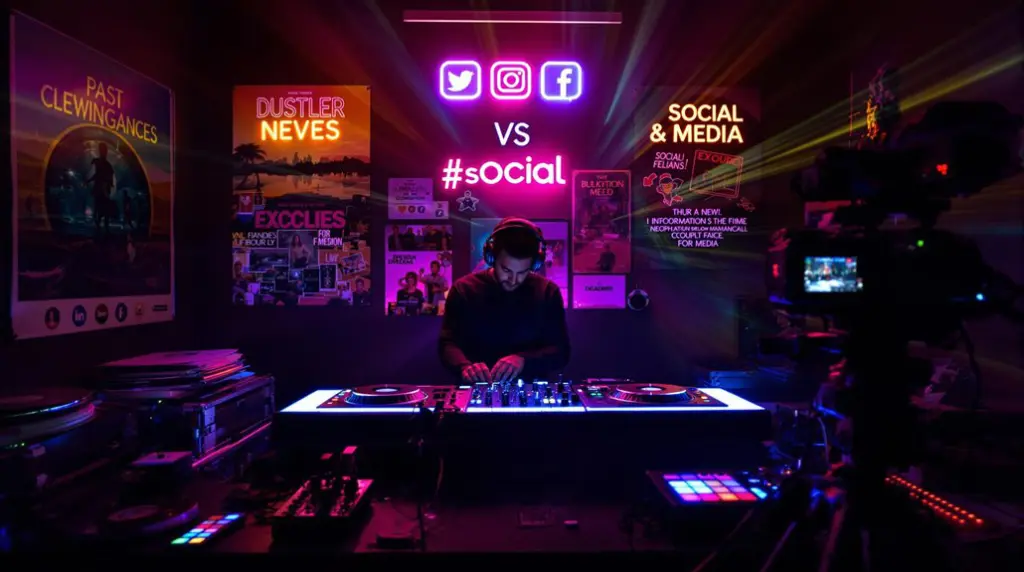Master mastering crowd reading is pivotal for any aspiring DJ, ensuring seamless energy and engagement on the dance floor. Early arrival for crowd observation aids in evaluating movement patterns and gauging energy levels. Key indicators such as swaying, jumping, or stillness provide real-time feedback, necessitating strategic musical choices. Techniques like call-and-response and familiar tracks encourage participation while allowing for adaptable musical shifts. Visual cue analysis and genre flexibility further maintain a dynamic atmosphere. Building a unique DJ brand via social media and professional materials enhances market presence. For deeper insights into fine-tuning these techniques, continue exploring our detailed guide.
Key Takeaways
- Arrive early to assess crowd energy levels and movement patterns.
- Observe physical dynamics like swaying, jumping, and stillness to gauge engagement.
- Monitor real-time audience reactions to adjust musical selections seamlessly.
- Use familiar tracks and call-and-response techniques to boost participation.
- Be flexible with genre choices to maintain a dynamic atmosphere.
Importance of Crowd Reading
How essential is it for a DJ to master the art of crowd reading? The answer is unequivocally critical. Effective crowd reading is synonymous with understanding crowd psychology, which is the cornerstone of maintaining a vibrant dance floor.
A DJ must be adept at gauging the mood and music preferences of the audience, tailoring their setlist to sustain high energy levels and engagement. Misjudging the crowd’s vibe can lead to disengagement and an empty dance floor, underscoring the importance of this skill. Employing techniques like mastering call and response can greatly enhance audience participation and energy.
Adjustments based on real-time audience reactions can transform an ordinary set into an extraordinary experience. A DJ’s confidence is inextricably linked to crowd engagement; a responsive audience fuels the DJ’s dynamism and creativity.
This symbiotic relationship highlights the need for keen observation and flexibility. Developing the ability to read the crowd is an iterative process, honed through countless performances. Each gig offers insights into crowd dynamics and evolving music preferences, enabling DJs to refine their approach.
Recognizing when to shift music selection is crucial for crowd retention. Timely, strategic shifts can reinvigorate a waning crowd, ensuring sustained energy and an unforgettable performance.
Mastering crowd reading is therefore indispensable for any aspiring DJ.
Observing Crowd Dynamics
Arriving 20-30 minutes before your set provides an invaluable window to assess crowd energy levels and movement patterns, essential for curating a responsive playlist.
Observing the crowd’s physical dynamics—whether they are swaying, jumping, or largely static—offers real-time feedback on their engagement and energy peaks. Analyzing these behaviors allows the DJ to make strategic adjustments, ensuring the set remains compelling and resonates with the audience.
Additionally, recognizing energy ebbs and flows in the crowd signals when it might be time to shift musical gears to maintain engagement.
Identifying Energy Levels
Understanding the energy levels of a crowd is a significant skill for any DJ aiming to create an unforgettable experience. Mastering this involves deciphering energy cues and movement signals.
Observing the dance floor closely is paramount; high energy levels manifest through enthusiastic movements like jumping and swaying, whereas stillness or minimal movement often signals disinterest or fatigue. These visual indicators are essential for dynamically adjusting your set.
Collective behaviors offer additional insights. A unified group of dancers moving energetically together signifies shared excitement, while isolated individuals may reveal a lack of engagement.
Facial expressions are equally telling; smiles and nodding heads indicate enjoyment, whereas frowns or lack of eye contact suggest a need for a musical shift.
Tempo adjustments are another advanced technique to manage energy levels effectively. If the crowd’s energy wanes, introducing a more upbeat track can re-energize the atmosphere.
Visual cues such as the movement toward the dance floor or clustering around specific tracks provide important feedback on which songs resonate most with the audience.
Analyzing Movement Patterns
A DJ’s ability to read crowd dynamics through movement patterns is a cornerstone of successful set management. By observing the dance floor, you can discern swaying patterns, jumping signals, and moments of stillness, each providing essential insight into the crowd’s energy levels and engagement. These patterns allow you to adapt your set in real-time, ensuring that the music resonates with the audience.
Analyzing how clusters of dancers interact versus solo dancers offers a deeper understanding of group dynamics. This can inform whether to maintain a high-energy track or shift to something more subdued. Eye contact and hand signals from the crowd often indicate connection and engagement or requests for specific tracks.
Facial expressions are another valuable indicator. Smiles generally suggest enjoyment, while frowns may indicate disinterest, guiding your next track choice. Additionally, noting when the crowd moves toward the dance floor can signal a readiness for more energetic selections.
| Movement Pattern | Indication |
|---|---|
| Swaying patterns | Moderate engagement |
| Jumping signals | High energy |
| Stillness | Disinterest or fatigue |
Adjusting Musical Selections
Understanding how to adjust musical selections is critical for maintaining crowd engagement and energy on the dance floor.
By meticulously monitoring real-time feedback such as audience reactions and energy shifts, DJs can strategically adapt genre choices and tempo to match the crowd’s vibe.
Quickly evaluating the crowd mood through non-verbal cues like swaying and energy levels can be incredibly effective.
Employing techniques like seamless shifts and incorporating popular requests guarantees a dynamic and responsive set that keeps the audience invested.
Identify Energy Shifts
Monitoring the dance floor for visible energy shifts is crucial for any DJ aiming to keep the crowd engaged and the atmosphere electric. Recognizing energy cues and crowd signals allows DJs to make informed decisions about their musical selections, ensuring a seamless flow of energy throughout the event.
To master this, consider the following techniques:
- Observe Physical Movement: Increased movement such as vigorous dancing or head-nodding indicates high energy, suggesting that the current track is resonating well. Conversely, a noticeable slowdown or sparse dance floor signals the need for a tempo adjustment.
- Gauge Subtle Reactions: Subtle cues like clapping, cheering, or even synchronized hand movements are positive crowd signals that the audience is enjoying the set. These indicators can guide you to maintain or boost the energy with similar tracks.
- Identify Restlessness: Moments of restlessness or disengagement, such as people leaving the dance floor or looking at their phones, suggest a drop in energy. This is the time to introduce more upbeat or familiar tracks to re-energize the crowd.
Additionally, implementing gradual tempo changes can help manage energy levels smoothly, while integrating crowd favorites or remixes can reignite enthusiasm when needed.
Mastering these techniques will help you maintain an electric atmosphere and keep the dance floor packed.
Adapt Genre Choices
How can a DJ effectively adapt their genre choices to maintain crowd engagement? Achieving this requires a deft balance of genre experimentation and astute observation of audience preferences.
Begin by incorporating familiar tracks early in your set to establish a rapport with the crowd. Monitoring the audience’s immediate responses—such as dancing, cheering, or moments of stillness—provides critical feedback for adjusting your musical selections.
Demographic cues, such as the age and attire of the attendees, can offer valuable insights into their musical tastes. Use these visual signals to tailor your setlist, ensuring it aligns with the crowd’s likely preferences. This strategic alignment can greatly enhance audience engagement and energy levels.
Be prepared to stay flexible with your setlist. If you notice a dip in energy or signs of disinterest, pivot effortlessly to a different genre or tempo.
This adaptability not only keeps the atmosphere vibrant but also demonstrates your capability to read the room effectively. Through continuous genre experimentation and real-time audience feedback, you can maintain an electrifying ambiance, ensuring that every track resonates with the crowd’s mood and preferences.
Engaging With the Audience
Engaging with the audience is a critical skill for any DJ working to enhance their performance from merely playing tracks to creating an unforgettable experience. Establishing a strong audience connection can greatly boost your set and foster an interactive performance. Here are three advanced techniques:
1. Eye Contact and Non-Verbal Cues: Maintaining eye contact enables you to create personal connections and receive real-time feedback.
Use nodding or hand gestures to encourage interaction and gauge audience enjoyment. This non-verbal communication is essential for real-time adjustments to your set. Direct engagement techniques like these can shape the performance direction, creating memorable experiences for everyone involved.
2. Familiar Tracks and Crowd Participation: Begin your set with familiar tracks to establish an engaging atmosphere.
This familiarity encourages the crowd to sing along, immediately creating a participatory environment. Call-and-response moments can further energize the audience, making them feel involved and fostering a sense of community. Balancing these familiar hits with new rhythms is key to keeping the energy alive throughout your set.
3. Observation and Adaptation: Pay close attention to who is dancing and responding positively.
This observation allows you to tailor your music selection in real-time, ensuring continuous engagement. By monitoring the crowd’s reactions, you can fine-tune your set to match their energy and preferences. Observing and responding to audience cues, like movements and facial expressions, can help you maintain a vibrant atmosphere.
Flexibility and Adaptability
In the ever-evolving landscape of live DJ performances, the ability to remain flexible and adaptable is essential. A refined setlist strategy must incorporate real-time feedback, enabling quick pivots in music selection to sustain crowd engagement. Observing audience reactions—such as dancing or stillness—provides important cues to gauge enthusiasm or disengagement.
| Technique | Purpose | Implementation |
|---|---|---|
| Visual Cue Analysis | Identify crowd’s energy levels | Observe dancing or stillness |
| Genre Switching | Maintain dynamic atmosphere | Change genres if energy dips |
| Mood Monitoring | Align music with crowd’s emotional state | Play uplifting tracks when audience appears bored |
| Request Integration | Enhance audience connection | Incorporate popular requests |
Expert DJs understand the necessity of spontaneous creativity, allowing them to react fluidly to the crowd’s unique dynamics. For instance, integrating popular requests can instantly reignite interest and enthusiasm. Flexibility in setlist planning is essential; leaving room for impromptu decisions guarantees the performance remains vibrant and engaging.
Building a DJ Brand
Crafting a memorable DJ brand requires a blend of musical artistry and strategic marketing acumen. Establishing a distinctive brand identity necessitates developing a unique musical style that mirrors your personal taste while resonating with audience preferences. This balance guarantees you stand out in a saturated market.
To enhance visibility, consider implementing a robust hashtag strategy to increase discoverability on social media platforms.
To foster a strong audience connection, leverage social media platforms. Regularly engage with your followers, share updates, and showcase your performances. This interaction cultivates a loyal fan base and extends your reach.
Additionally, creating professional promotional materials is essential. High-quality mix tapes, logos, and bios highlight your skills and experiences, attracting potential gigs and collaborations.
Networking plays a pivotal role in brand building. Attend industry events to connect with other DJs and promoters. This exposure allows you to gain insights, share experiences, and explore collaboration opportunities, further enhancing your brand’s visibility.
To paint a clearer picture, consider these steps:
- Develop Your Style: Craft a unique musical style that balances personal taste with audience preferences.
- Engage on Social Media: Use platforms to interact with your audience and share content.
- Create Professional Materials: Design mix tapes, logos, and bios to showcase your expertise.
Regularly updating your music library with trending tracks while maintaining versatility reinforces your brand identity and guarantees you cater to diverse audiences.
Frequently Asked Questions
How to Read a Crowd While DJING?
To effectively read a crowd while DJing, observe crowd energy and body language meticulously. Adapt your music selection dynamically, leveraging high-energy tracks during peak moments and maintaining flexibility in genres and tempos to sustain dancefloor engagement and enjoyment.
How to Engage With the Crowd as a DJ?
Engage with the crowd by mastering crowd dynamics through techniques such as call-and-response and maintaining eye contact. Foster audience interaction by responding to song requests and observing real-time reactions to tailor your set and sustain energy levels.
How Does a Beginner DJ Start?
A beginner DJ should focus on gear setup, selecting appropriate equipment choices and software options. Mastering music selection and mixing techniques is essential, along with practicing seamless track shifts to guarantee a polished and dynamic performance.
How Do You DJ a Party for Beginners?
For beginners, DJing a party involves mastering music selection, developing a dynamic playlist strategy, honing mixing techniques, and understanding equipment basics. Observing crowd reactions and adapting your set in real-time guarantees a seamless and engaging experience.
Conclusion
Mastering the art of crowd reading is indispensable for any aspiring DJ. By meticulously observing crowd dynamics, making astute musical adjustments, and actively engaging with the audience, a DJ can markedly enhance the overall experience. Flexibility and adaptability are key in responding to the fluid nature of live events. Additionally, building a strong DJ brand through consistent performance and audience connection solidifies one’s reputation in the industry. Achieving proficiency in these areas is essential for long-term success.




